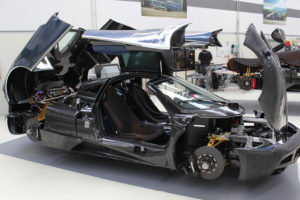A rapidly growing demand for carbon fiber is stressing market ability to provide.
Although carbon fiber as a commodity has been around since the late 1960s, only in the past 10 years can there truly be considered a dynamic market of real substance with steady growth potential. A market report published in Reinforced Plastics Nov/Dec 2014, estimated that global commodity carbon fiber could expect an annual yearly growth rate of around 15 percent.1 A more recent report in November 2016 on the worldwide growth of composites (of which carbon fiber plays a major role) predicted annual rates of 5–8 percent.2 Others are more cautious, citing the ongoing challenge of demand for carbon fiber composites outstripping the ability of industry to produce it in the volumes needed by composites industries.
Price vs. volume vs. supply chain
Carbon fiber production is an energy-intensive process. According to an Engineering Materials report in its Winter 2014 issue, not many produce it in bulk—notably Japan and the United States—and the worry is that supply will not keep up with the expected seven-fold increase in demand.
“For some time, carbon fiber was restricted to low-volume industries with big budgets, such as Formula One cars and military fighter jets. However, mainstream aircraft manufacturers have invested in carbon fiber in a major way and this medium volume venture has been met with such success that it is now difficult to envisage a major aircraft manufacturer using anything else in the primary structure,” the report says.
Yet cost still remains a challenge. “The carbon fiber composites market is growing steadily,” says Adrian Wilson, editor of Inside Composites,3 “but the problem is still the price. To install a new carbon fiber line requires an investment of around €100-million, and that adds just an annual 2,000 tons of capacity.” However, says Wilson, “The Japanese Big Three (Toray,

Teijin and Mitsubishi) are reported to be close to commercializing new carbon fiber precursors they think will boost a line’s output to 20,000 tons. If that happens, the adoption by the automotive industry for car bodies will become feasible.”4
“The use of composites throughout industry has been on an upward and expanding path this past decade, but composite materials are topping out, at least within aerospace,” says Justin Cunningham, editor of Engineering Materials, in his June 2016 editorial. “The current ratio of composites to other materials for mid-size airliners and above will remain around the 55 percent mark.”
However, Cunningham predicts trends will cool off somewhat: “The fact is, composites, like all materials, cannot do everything, and metals and indeed plastics are innovating as much as possible to take that ratio back down below 50 percent.”
Shifting from production to process
At the annual JEC Paris composites show held in March 2016, emphasis has shifted away from weight reduction production to throughput process. “The talk was once all about the possibilities, but this year that’s turned firmly on to practicalities,” says Cunningham reporting on the Paris show in the June issue of Engineering Materials. “While the composites industry has always been inextricably linked to lightweight parts, this year’s show was keen to highlight that high-volume composite parts aren’t a pipe dream, but a production-ready reality.”
The biggest drivers are coming from the aerospace industry and quickly catching up the automotive industry, especially BMW with its iSeries electric cars, where strong, but exceptionally light composite frames contribute efficiencies.
Production of fiber and improved composite manufacturing processes designed for large volume are highly dependent on speed and new methods to overcome traditional fabrication technology. When whole industries demand innovation, new methods inevitably arise.
“The [Boeing] Dreamliner and Airbus A380 planes with their 50 percent composite construction have attracted all the initial hype and BMW’s iSeries electric cars may yet do the same for automotive,” says Wilson. “But there are a lot of other ifs and buts, not least the automation of mass manufacturing processes capable of series car production.” Faster industry composite production still remains the barrier to the source of more carbon fiber that meets high tensile/flexibility ratios at reasonable prices.
Innovations opening up markets
Reducing prices while increasing production of carbon fiber to the high volumes needed, although difficult, may have a new breakthrough and champion with the recent announcement of a joint partnership between the Oak Ridge National Laboratory’s Carbon Fiber Technology Facility (CFTF) and LeMond Composites, a company founded last summer by former professional cyclist and entrepreneur Greg LeMond, to produce low-cost carbon fiber in volume.

Oak Ridge National Laboratory (ORNL), Knoxville, Tenn., and the CFTF developed a technology it claims can reduce the cost of carbon fiber by as much as 50 percent. “ORNL successfully produced carbon fibers from an industrial textile that was not intended to be used as a carbon precursor,” says Amit Naskar, one of the inventors and the group leader for carbon and composites at ORNL.5 “Carbon fiber manufacturing using polyacrylonitrile (PAN)-based precursors is well known and it has been practiced by industry for several decades.”
According to the report, less than 5 percent of the PAN fiber produced globally is used in the manufacture of carbon fiber with the bulk of production a textile-grade PAN—and therefore a commodity product with a lower cost than higher-quality tow. The CFTF facility has a 120m meltspun fiber line that can produce raw fiber and includes a thermal conversion line able to produce 28 tons a year of PAN fiber and can convert both melt-spun and solution-spun precursors.
“This new carbon fiber has the mechanical properties of carbon fiber costing three times as much,” says LeMond. “Until now, manufacturing carbon fiber was an extremely energy-intensive process. This new method reduces energy consumed during production by up to 60 percent.”6 LeMond Composites, located near ORNL, plans to make its first commercial fiber product available by early 2018.
With costs coming down, many new markets should see increased use of carbon fiber. Besides a logical increased usage in the automotive and aeronautic industries, other fields will see growth as well, such as sporting goods, wind turbines and construction. However, building and construction is currently dominated by glass-fiber composites and it will take the efforts of manufacturers with foresight and efficiencies to counteract these tendencies with lower-cost, carbon fiber-based composites before the trend changes.
The main barrier that holds back these new applications is speed of material processing when producing composites; however, research and innovations in processing are being made by companies such as Hexcel, Solvay and Henkel where higher permeability and faster throughput are meeting industry demands for faster production.
“The aerospace industry, and others, are demanding faster processability from materials,” says Cunningham. “Weight is no longer the must-have key driver. Mounting backlogs are putting both Airbus and Boeing under pressure to get aircraft out the door. Chasing a few kg here or there is no longer the obsession it once was.” And that is composites, another story entirely.
Bruce N. Wright, AIA, and principal of Just Wright Communications, specializes in reporting on materials, textiles and architecture, and is a regular contributor to Advanced Textiles Source, Specialty Fabrics Review and Fabric Architecture.
 TEXTILES.ORG
TEXTILES.ORG


